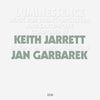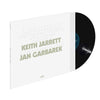



Keith Jarrett and Jan Garbarek - Luminessence - Music For String Orchestra And Saxophone
Tenor Saxophone, Soprano Saxophone – Jan Garbarek
Strings – Strings Of Südfunk Symphony Orchestra, Stuttgart
Conductor – Mladen Gutesha
Composer – Keith Jarrett [click here to see vinyl featuring Keith Jarrett]
1 LP, standard sleeve
Original analog Master tape : YES
Heavy Press : 180g
Record color : black
Speed : 33 RPM
Size : 12'’
Stereo
Studio
Record Press : unspecified
Recorded in April 29, 1974 & April 30, 1974 at Bauer Studios, Ludwigsburg, Germany
Engineered by Kurt Rapp, Martin Wieland
Produced by Manfred Eicher
Photography by Kira Tolkmitt, Terje Mosnes
Cover Design by Barbara & Burkhart Wojirsch, Sascha Kleis
Originally released in 1975
Reissued in March 2024
Tracks :
Side A:
- Numinor
- Windsong
Side B:
- Luminessence
Reviews:
“Keith Jarrett does not actually play on this LP; rather, he composed three angst-ridden pieces of varying lengths for string orchestra, over which Jan Garbarek improvises on tenor and soprano saxes. The concept is not unlike that of Stan Getz's Focus, but this music is far more static, downcast, and free of the pulse of jazz. As was characteristic of his writing then, Jarrett's string parts are mostly turgid and thick-set, indulging in weird, sliding microtones on "Windsong," weighted down by some kind of emotional burden. Particularly when delivering piercing sustained notes on soprano, Garbarek often sounds like a native of the Middle East. The strings are from the Stuttgart Radio Symphony, led by Mladen Gutesha, who faithfully executes Jarrett's dolorous wishes.” AllMusic. Review by Richard S. Ginell.
"At the time of this recording, Garbarek was a member of Keith Jarrett’s European Quartet and so the two would have spent much time playing and listening to each other. This fact comes across strongly in Jarrett’s writing for the saxophonist with three pieces for string orchestra and improvising musician.
The rapport between Jarrett and Garbarek is so strong it is impossible to imagine anyone else playing this music. Jarrett has got right to the heart of the music in his beautiful, stirring and at times enigmatic writing and the saxophonist is given a wonderful canvas for his improvisations.
The Garbarek sound is now firmly established, the keening sound of both soprano and tenor saxophones with their impassioned and vocal cries that reach deep into the soul. The score allows the saxophonist to follow his own path, and any sense of linear development is left to the string orchestra as Garbarek casts his phrases in the air. The opening ‘Numinor’ has its moments of darkness, but lifted by the strings the tenor saxophone throws caution to the wind and the last third of composition has some declamatory statements from Garbarek.
Similarly, the shorter ‘Windsong’ that features the soprano saxophone moves from its lyrical and lush opening theme to a more turbulent passage with Jarrett creating a drone for Garbarek to improvise over. The final piece on the album is the most overtly joyous, and possibly the most satisfying. The opening by the strings is quite dramatic making effective use of the lower register members of the orchestra that then opens up in to a rich and full musical tapestry setting up Garbarek’s most lyrical and expansive solo.
As the mood lightens in the orchestral arrangement, so the saxophonist follows suit, bring to a close a spectacular what must surely be regarded as a three-part suite.
Jarrett must have been pleased with the results as was producer Manfred Eicher, and six months later Jarrett and Garbarek would be back in the studio with bassist Charlie Haden and Members of the RSO Stuttgart to record Arbour Zena, with Jarrett this time playing piano as well as having composed the music. Listening again to Luminessence one marvels at the detail in the orchestration and the playing of Jan Garbarek.
ECM was a still a relatively new label at the time of recording this ambitious work and both Jarrett and Garbarek were not thirty years old. If much of their best work was still ahead of them, then Luminessence is a remarkable achievement that has not dated at all." JazzNews Review by Nick Lea
Ratings :
AllMusic : 4 / 5 ; Discogs : 3.95 / 5 ; Encyclopedia of Popular Music : 3 / 5 ; The Penguin Guide to Jazz : 2.5 / 4 ; The Rolling Stone Jazz Record Guide : 3 / 5


